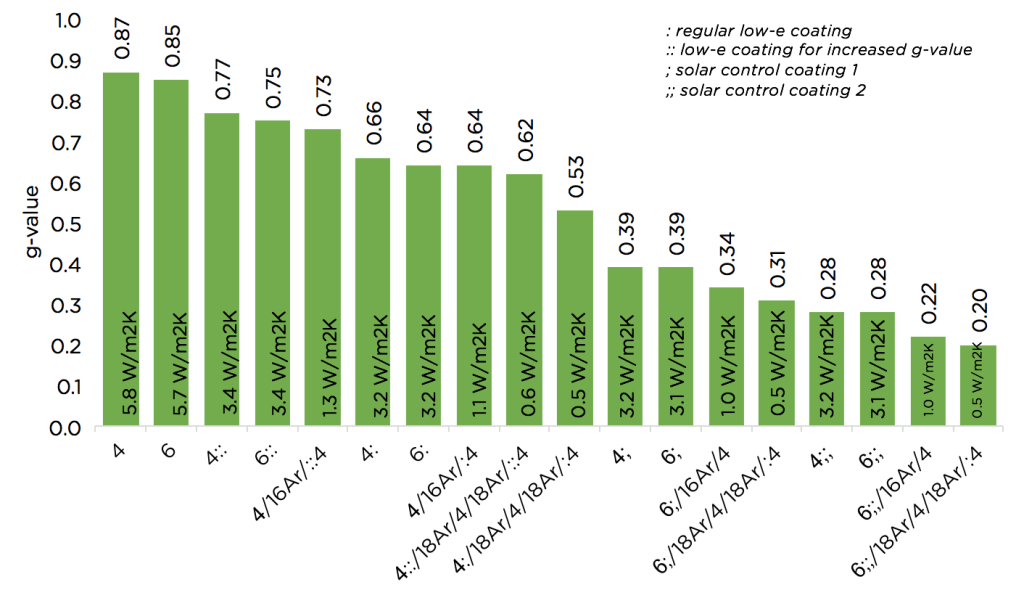When talking about insulated glass units (IGU) we normally consider thermal transmittance of IGU (Ug) which varies between 1.0 W/m2K and 1.4 W/m2K for double glazing and between 0.5 W/m2K and 0.8 W/m2K for triple glazing which we already wrote about in some of previous blog posts. Beside Ug there is another important characteristic of IGU which might even have greater impact on inside climate conditions – solar gain which is in Europe commonly expressed with special coefficient called solar factor or total solar energy transmittance or g-value. In United States it is commonly used Solar Heat Gain Coefficient or SHGC.
Solar gain, also called solar heat gain, is a combination of energy transmitted directly through the IGU (g) and energy absorbed by the IGU (qi) which is re-radiated into the space. G-value of 1.0 represents full transmittance of solar radiation through the IGU, which means maximum possible solar gain, whereas g-value of 0 represents that IGU has no solar gains. Very clear float glass can reach up to 0.91, whereas regular uncoated float glass with thickness of 4 mm has g-value of 0.87 and 6 mm of 0.85. 4 mm float glass coated with standard low-e coating (marked as : in this post) has g-value of 0.66, double IGU with low-e coating (4/16Ar/:4, Ug=1.1 W/m2K) of 0.64, and triple IGU with low-e coatings (4:/18Ar/4/18Ar/:4, Ug=0.5 W/m2K) of 0.53.

Transmittance of solar energy combined of energy transmitted directly through the IGU (g) and energy absorbed by the IGU (qi) (http://www.glassadvisor.com/scanner/)
Due to a demand of increasing thermal efficiency of buildings in central and northern Europe (passive, nearly zero and plus energy houses), IGUs with increased g-values are commonly installed on southern and eastern side of buildings with an aim to receive as much solar gain as possible in winter months. Therefore special low-e coatings (marked as :: in this post) are applied to glass panes which results in g-value of single float glass of 0.77 (4::), double IGU of 0.73 (4/16Ar/::4) and g-value of 0.62 for triple IGU (4::/18Ar/4/18Ar/::4). We must be careful here as increasing of the g-value consequently leads also to an increase of Ug as shown in diagram. In this case, more solar energy is received from sun in winter, consequently leading to more intensive warming of internal space and lower expenses for heating. On the other side this can cause serious overheating in summer and therefore appropriate external blinds must be consider.

g-value and Ug of different single, double and triple IGUs calculated with SILVERSTAR glaCE sofware
At warmer locations (e.g. California, southern coasts of Europe, Middle east, etc.) there is an opposite situation and IGUs with lower g-values should be used as we are aiming to reduce the solar energy transmittance to avoid overheating. In such cases we are considering g-values down to even 0.20. Some classic double glazing (6;/16Ar/4) with solar control coating for e.g. southern France coastal region (marked as ; in this post) might obtain g-value of 0.34 whereas same structure for hot California (marked as ;; in this post) should have even lower g-value of 0.22. Opposite to the situation where we are increasing g-value, here the Ug value is decreased in some cases as presented in diagram.
As presented, g-value of IGU is an important characteristic and should be considered when installing windows in different regions and even different sides of buildings to get an optimal combination of insulation and solar gains and to avoid intensive overheating of inner spaces.


